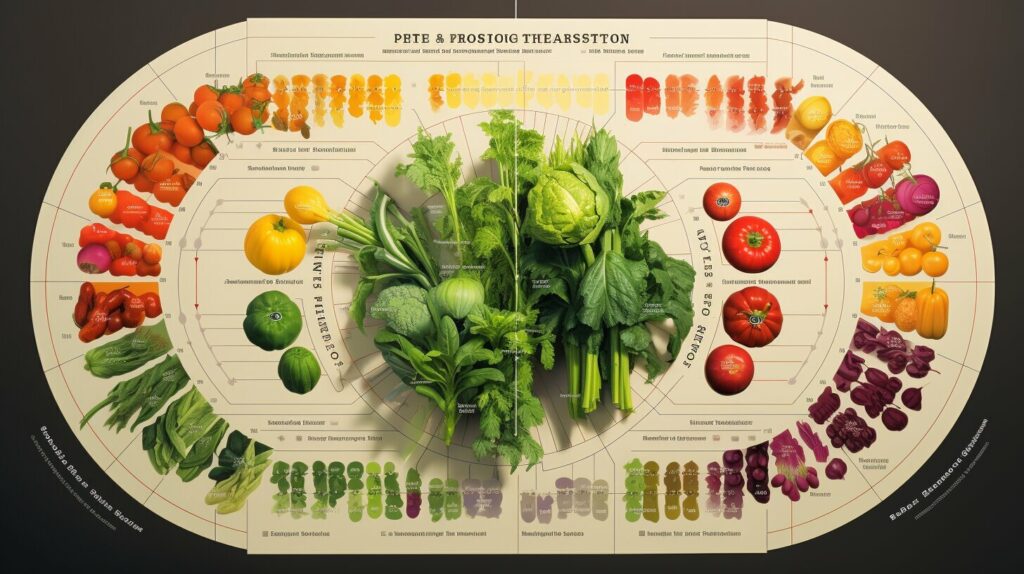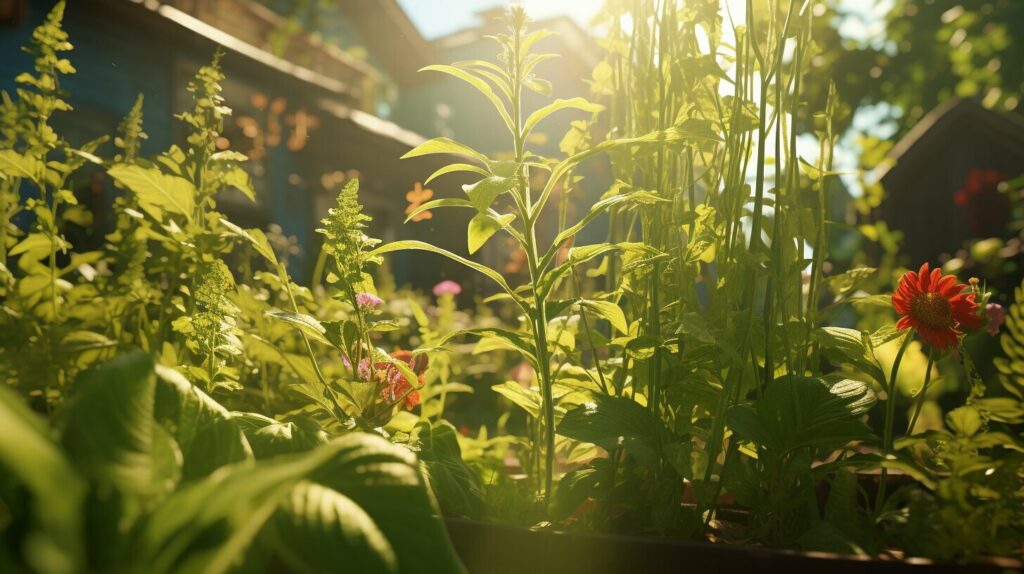Are you looking to create a sustainable, productive, and beautiful garden? Look no further than organic companion planting! This gardening technique involves strategically planting certain plants together to promote healthy growth and deter pests naturally.
By selecting compatible plant combinations, you can create a harmonious ecosystem in your garden where plants support and benefit each other. In this article, we will explore the art of organic companion planting and how it can help you grow the perfect garden.
Key Takeaways of Our Companion Planting Guide:
- Organic companion planting involves strategically planting certain plants together to promote healthy growth and deter pests naturally.
- Selecting compatible plant combinations creates a harmonious ecosystem in your garden where plants support and benefit each other.
- Organic companion planting is a sustainable, productive, and beautiful way to grow a garden.
- By attracting good insects and utilizing natural control methods, you can cultivate a thriving garden ecosystem.
- Start your green journey today and discover the wonders of organic companion planting!

What is Organic Companion Planting?
When it comes to creating a thriving garden, traditional gardening methods often rely on chemical fertilizers and pesticides that can harm the environment and our health. Organic gardening, on the other hand, involves using natural solutions to grow healthy plants, and companion planting is one of the essential techniques.
Companion planting is a method of planting different crops together in the same garden bed to create a mutually beneficial environment. Organic companion planting is the practice of doing this without using any synthetic fertilizers, pesticides, or other chemicals.
Read More OutdoorGoodness Articles:
Whether you’re an experienced gardener or just starting, organic companion planting is an excellent way to create a vibrant and sustainable garden that benefits both you and the planet.
By using organic companion planting in your garden, you can reduce your environmental impact and create a more diverse and productive garden. Plus, it’s a fun and rewarding way to connect with nature and grow your own food.

Benefits of Organic Companion Planting
By practicing organic companion planting, we can reap numerous benefits for our garden. One of the most significant advantages is natural control. Instead of relying on chemical insecticides, we can attract better insects like ladybugs and lacewings to prey on common pests like aphids and mites. This not only reduces the use of harmful chemicals but also promotes a healthy garden ecosystem.
In addition to pest control, companion planting can also suppress weed growth, saving us time and effort in garden maintenance. Some plants, like marigolds, have natural weed-suppressing properties, while others like thyme and chamomile release chemicals that inhibit weed growth.
Companion planting also improves soil health by fixing nitrogen. Some plants, like peas and beans, are nitrogen-fixing, which means they absorb nitrogen from the air and deposit it into the soil. This helps fertilize neighboring plants, leading to better growth and yield.
Lastly, companion planting enhances pollination, leading to higher yield and better-quality crops. Certain plants, like sunflowers and dill, attract pollinators like bees and butterflies to the garden, while others like squash and pumpkins are pollinated by bees and other insects.
Overall, organic companion planting is a sustainable and productive way to grow our garden, promoting a healthy garden ecosystem and reducing our reliance on harmful chemicals.
With natural controls, weed suppression, soil health improvement, and enhanced pollinating, we can create a beautiful and thriving garden. Let’s take the first step towards a greener future by practicing organic companion planting!

Understanding Plant Relationships in Companion Planting
When it comes to organic companion gardening, the key to success lies in understanding the relationships between different plants. Certain plants help each other by providing essential nutrients, while others repel pests or improve soil conditions. By incorporating these relationships into our gardening practices, we can create a thriving, sustainable garden.
For example, cabbage and thyme make excellent companions. Thyme can help deter cabbage moths from laying their eggs on the cabbage plants, which can then hatch and cause damage to the leaves. Similarly, squash and radish are a great pairing, as radish can help repel squash bugs.
| Plant | Companion Plants | Non-Companion Plants |
|---|---|---|
| Cabbage | Thyme, beets | Pole beans, strawberries |
| Squash | Radish, corn, marigold | Potatoes, brassicas |
| Beet | Lettuce, onion, chard | Mustard greens |
| Lettuce | Carrots, radish, chives | Parsnips, celery |
| Pea | Carrots, turnips, radish | Garlic, onions |
| Radish | Lettuce, cucumber | Hyssop, beans |
| Thyme | Cabbage, eggplant, tomato | Mint, sage |
It’s important to note that not all plant pairings work well together. For example, planting cabbage and pole beans together can actually hinder the growth of both plants. It’s always a good idea to research the specific plants you plan to use in your garden and their compatible companions.
By understanding plant relationships and using them to our advantage, we can create a thriving garden that benefits both the plants and the environment. Let’s continue to explore the wonderful world of organic companion planting!

Companion Planting for Vegetable Gardens
If you’re looking to maximize the productivity of your garden, companion planting is an invaluable technique to consider. By strategically pairing plants that complement each other, you can enhance the overall health and yield of your crops while also minimizing the effects of pests and diseases.
One popular combination is planting brassicas like cabbage and kale near leeks. The leeks naturally repel pests like onion flies and moth larvae, which can otherwise decimate a brassica crop. Pole beans and corn are another effective combination, as pole beans can climb the corn stalks for support while also repelling cucumber beetles that would otherwise feed on the corn.
Another plant that can play a crucial role in companion planting is pumpkin. When planted alongside other vegetables, pumpkin plants can act as a natural mulch and weed suppressant, reducing the need for manual weeding. They also have a symbiotic relationship with certain crops, such as cucumbers and melons, which benefit from the shade and moisture retention provided by the pumpkin’s large leaves.
To create a successful companion planting garden, it’s important to understand which plants work well together and which should be kept separate. Proper spacing and timing of planting can also play a critical role in ensuring that each plant has the necessary resources to thrive.
By incorporating companion planting into your garden, you can support a thriving ecosystem that benefits not only your crops but also the pollinators and beneficial insects that help keep your garden healthy.
So, here are really great organic companion plants:
Lettuce
Lettuce is a wonderful companion plant in organic gardening. Its tall and leafy nature provides shade and acts as a living mulch, helping to suppress weeds and retain soil moisture. Lettuce also attracts beneficial insects like ladybugs and lacewings, which prey on harmful insects such as aphids and caterpillars.
Additionally, lettuce roots release compounds that suppress the growth of nematodes, microscopic organisms that can damage the roots of many plants. When used as a companion plant, lettuce can be interplanted with a variety of vegetables, helping to maximize space and increase biodiversity in the garden. It can be grown next to tomatoes, cucumbers, carrots, and radishes, among others.
Marigolds
Marigolds are widely used in organic gardening as companion plants due to their many beneficial properties. They have a strong scent that repels insects such as aphids, mosquitoes, and whiteflies, making them excellent allies to protect nearby vegetable plants.
The marigold’s roots also release a chemical into the soil that suppresses the growth of nematodes, microscopic worms that can damage the roots of plants.
Cabbage and Cauliflower
Cabbage and cauliflower are two popular vegetables that are commonly used in organic companion planting. These plants are known to have a beneficial relationship with each other, as they help to deter pests and improve overall plant health.
Cabbages and cauliflowers release natural chemicals into the soil that repel certain pests, such as cabbage worms and aphids. By planting them together, they create a natural barrier that can help to protect both plants from these unwanted visitors.
Peas
Peas are a popular choice for organic companion planting due to their ability to fix nitrogen in the soil. Nitrogen is an essential nutrient for plant growth, and by planting peas alongside other vegetables, they can help improve the overall soil fertility.
Peas have a symbiotic relationship with bacteria called rhizobia, which colonize their roots and convert atmospheric nitrogen into a form that plants can use. This nitrogen-fixing ability of peas not only benefits the pea plants themselves but also neighboring crops.
Peas can be planted in proximity with nitrogen-demanding plants like corn, squash or tomatoes, providing a natural source of nitrogen for these crops.
Radishes
Radishes are often used for organic companion planting due to their ability to deter pests and improve the growth of other plants. One of the main benefits of planting radishes as companions is their ability to repel harmful insects such as aphids, cucumber beetles, and flea beetles.
The strong aroma and sulfur compounds in radishes help to mask the scent of neighboring plants, making it difficult for pests to locate and attack them.
Additionally, radishes have been found to attract beneficial insects like ladybugs and lacewings, which feed on aphids and other damaging pests. Another advantage of growing radishes alongside other vegetables is their ability to enhance soil health.
Radish roots help to break up compacted soil, improving drainage and access to nutrients for neighboring plants. They also increase organic matter in the soil as their roots decompose, further enriching its fertility.
Thyme
Thyme is a popular herb used in organic companion planting due to its many beneficial qualities. It is known to attract beneficial insects such as bees and butterflies, which helps with pollination in the garden. Thyme also acts as a natural repellent for pests like cabbage worms, aphids, and cabbage loopers, making it an excellent companion for vegetables in the brassica family, such as broccoli, cabbage, and kale.
Additionally, thyme has strong antimicrobial properties and can help prevent fungal diseases in plants. Its low-growing and spreading habit also makes it a great ground cover, suppressing weed growth and preserving soil moisture. Thyme is a hardy plant that can handle a variety of growing conditions, including full sun, partial shade, and well-drained soil.
Dill
Dill is a popular herb that is often used for organic companion planting. It is known for its ability to attract beneficial insects such as bees and butterflies, making it an excellent choice for attracting pollinators to your garden. Dill is also believed to repel harmful insects such as aphids, spider mites, and cabbage loopers, making it a useful companion plant for protecting your other crops.
Additionally, dill can enhance the flavor of certain vegetables when planted nearby, such as cucumbers and tomatoes. It is also believed to increase oil production in nearby plants, making it a beneficial companion for oilseed crops.
Dill is relatively easy to grow, requiring full sun and well-drained soil. It is a versatile herb that can be used both in the kitchen and in the garden, making it a popular choice for organic gardeners looking to maximize the health and productivity of their crops.
Beets
Beets are a versatile vegetable that not only offer health benefits when consumed but also serve as an excellent companion plant in organic gardening. One of the key advantages of utilizing beets in companion planting is that they attract beneficial insects such as ladybugs and lacewings, which prey on pests like aphids and mites.
By planting beets alongside other crops, gardeners can help maintain a natural balance and reduce the need for chemical pesticides.
Nasturtium
Nasturtium is a popular choice for organic companion planting due to its many benefits. First and foremost, nasturtiums attract beneficial insects such as bees and butterflies, which help with pollination in the garden.
Additionally, the flowers of the nasturtium plant produce nectar that attracts hoverflies and other insects that feed on garden pests like aphids. This natural pest control can greatly reduce the need for chemical interventions in the garden.
Chive
Chives are a versatile herb that can be used for organic companion planting. When planted alongside vegetables such as carrots, tomatoes, and roses, chives can help repel harmful insects. The strong scent of chives acts as a natural deterrent for pests like aphids, carrot flies, and Japanese beetles. Chives also attract beneficial insects such as bees, which help with pollination.
Sunflower
Sunflowers are a versatile and beneficial addition to organic companion planting. One of the main benefits of planting sunflowers is their ability to attract pollinators, such as bees and butterflies, to the garden. These pollinators are essential for the successful growth and reproduction of many fruits and vegetables.
Borage
Borage, also known as starflower, is a popular choice for organic companion planting. This herb is not only a beneficial companion plant but is also a highly attractive addition to any garden. Borage attracts bees and other beneficial insects, making it an excellent companion for pollinator-dependent crops such as tomatoes and squash.
It also acts as a pest repellent, particularly against tomato hornworms. The strong scent of borage can deter these harmful insects from infesting nearby plants.
Brussels Sprouts
Brussels sprouts are often used in organic companion planting due to their beneficial effects on surrounding crops. They belong to the brassica family, which also includes broccoli, cabbage, and kale, and can be grown alongside these plants to maximize their yields.
Brussels sprouts have deep roots that help to improve soil structure and drainage, making them an ideal companion for plants that require well-drained soil.
Parsnips
Parsnips are a versatile and nutritious vegetable that can be used for organic companion planting in the garden. Companion planting is the practice of growing different plants together that benefit each other in some way.
When it comes to parsnips, they can be a beneficial companion to several other vegetables. For starters, parsnips can help deter pests such as carrot flies when planted alongside carrots, as the strong scent of parsnips can mask the smell of the carrots.

The Three Sisters Companion Planting Method
When it comes to companion planting, the three sisters method (or TSM) is one of the oldest and most popular techniques. This Native American tradition involves planting corn, squash, and beans together in a mutually beneficial relationship.
| Plant | Benefit |
|---|---|
| Corn | Provides support for the beans to grow while enhancing soil nitrogen levels for future crops. |
| Squash | Acts as a natural ground cover, preventing weed growth and retaining moisture. |
| Beans | Fix nitrogen in the soil, enriching it for future crops. |
Together, these three plants create a harmonious ecosystem in which each one benefits from the others. The corn provides support for the beans to grow, while the beans fix nitrogen in the soil, enriching it for future crops. The squash acts as a natural ground cover, preventing weed growth and retaining moisture, while also deterring pests that would otherwise harm the other plants.
If you’re interested in trying the TSM in your garden, start by planting corn in a mound and then, when it’s about six inches tall, add bean seeds around the base. Once the beans are growing, add squash seeds around the perimeter. Be sure to choose varieties that are compatible and plant them at the right time.
With the TSM, you can grow a beautiful, sustainable garden that honors ancient agricultural traditions and supports the health of your local ecosystem.

Creating a Companion Planting Chart
Planning your companion planting can seem daunting at first, but a companion planting chart can make the process much easier. A companion planting chart is a visual reference of compatible plant combinations that helps you maximize the benefits of companion planting.
The first step in creating a companion planting chart is to determine which plants you want to grow in your garden. Consider the light, water, and nutrient requirements of each plant to ensure they are compatible.
Once you’ve selected your plants, it’s time to start charting. Begin by listing the name of each plant and then identify their companion plants. For instance, parsnips sow well with beans and peas, while thyme is a great companion for cabbage.
| Plant | Companion Plants |
|---|---|
| Parsnip | Beans, peas, garlic, onion |
| Thyme | Cabbage, eggplant, tomatoes |
Be sure to include information on plants that do not grow well together, such as fennel and dill. These two plants can inhibit the growth of many other plants, so it’s best to keep them away from your garden altogether.
Your companion planting chart should also include information on pest-repelling plants, such as borage and marigold, and plants that attract pollinators, like sunflowers and lavender.
As you create your companion planting chart, keep in mind the specific needs and growth habits of each plant. Some plants may require more space than others, so be sure to factor this into your chart.
With your companion planting chart in hand, you’ll be able to create a garden that is both beautiful and productive. Happy planting!

Tips for Successful Organic Companion Planting
Companion gardening is a wonderful way to create a sustainable, productive, and beautiful garden. With proper planning and care, you can create a harmonious ecosystem where plants support each other and pests are deterred naturally.
When selecting companion plants, consider those that have natural repellent properties. For example, planting borage with tomatoes can deter tomato hornworms, while planting beets with garlic can deter flea beetles. By selecting plants with complementary growth habits and nutrient requirements, you can maximize their beneficial effect on each other.
It’s also important to consider the spacing requirements of each plant. For instance, Brussels sprouts grow best when planted near celery and spinach, but require ample space for optimal growth. Similarly, plants like carrots and radishes can be interplanted to maximize space and improve soil health.
Additionally, it’s important to understand the role of beneficial insects in companion planting. Attracting pollinators like bees and butterflies can improve the overall health and productivity of your garden. Consider planting flowers like lavender and marigold alongside your vegetables to attract these important pollinators.
Remember that organic companion planting is about creating a diverse ecosystem in your garden. By selecting compatible plants, utilizing natural repellants, and attracting beneficial insects, you can create a thriving garden that requires minimal maintenance and chemical intervention.
As you continue on your green journey, we encourage you to experiment with different combinations of companion plants and share your experiences with other gardeners. Together, we can create beautiful and sustainable gardens that benefit both our communities and our planet.
Harvesting and Maintaining Your Companion Planting Garden
Proper maintenance is key to a thriving companion planting garden. Weeds are a common issue in any garden, but they can be especially problematic in a companion planting environment. We recommend pulling weeds by hand to avoid disrupting the soil and damaging your plants. A layer of mulch can also help prevent weed growth and retain moisture.
When it comes to harvesting, it’s best to pick fruits and vegetables when they are fully ripe to ensure maximum flavor and nutritional value. Regular harvesting also encourages continued growth and can prevent plants from becoming overcrowded.
Despite your best efforts, some garden pests may still make an appearance. If you notice signs of infestation, such as chewed leaves or wilting plants, try to identify the culprit before taking action.
Certain pests can be deterred by companion plants like borage, which repels tomato hornworms and cabbage moths. If necessary, you can also use natural control methods like insecticidal soaps or neem oil.
Remember, maintaining a healthy and productive garden takes time and effort, but the rewards are worth it. By following these tips for weed control, harvesting, and pest management, your companion planting garden is sure to thrive.
Conclusion
As we wrap up our exploration of organic companion planting, we hope you feel inspired to start your green journey. Whether you’re a seasoned gardener or just starting, companion planting is a valuable technique that can help you cultivate a thriving garden ecosystem.
By harnessing the power of plant relationships, attracting beneficial pollinators and insects, and utilizing natural pest control methods, we can create beautiful and sustainable gardens.
Remember, organic companion planting is not a one-time task. It requires ongoing care and attention to maintain healthy plant growth and manage garden pests. But with dedication and patience, the rewards are plentiful, including higher yield and better-quality crops, a more beautiful garden landscape, and a deeper appreciation for the natural world around us.
Join us on the green journey
We invite you to join us on this green journey and discover the wonders of organic companion planting. Through trial and error, experimentation, and learning from others, we can continue to improve our gardening skills and create sustainable and productive gardens. Let’s work together to protect our pollinators, nurture our plants, and promote a healthier and more beautiful world for all of us.
FAQ
Q: What is organic companion planting?
A: Organic companion planting is a gardening technique that involves strategically planting certain plants together to promote healthy growth and deter pests naturally.
Q: What are the benefits of organic companion planting?
A: Organic companion planting offers a multitude of benefits, including pest control, improved soil health, weed suppression, and enhanced pollination.
Q: How do different plants interact in companion planting?
A: Different plants have different relationships in companion planting, and understanding these relationships is crucial in creating successful combinations.
Q: Which plants are particularly beneficial in companion planting?
A: Marigold, nasturtium, sunflower, dill, chive, and chamomile are popular choices for their pest-repelling or attracting properties.
Q: How can companion planting benefit vegetable gardens?
A: Companion planting can help deter pests and provide support for vegetables in a garden.
Q: What is the TSM companion planting method?
A: The TSM companion planting method involves planting corn, squash, and beans together to utilize their mutually beneficial relationships.
Q: How can I create a companion planting chart?
A: Creating a companion planting chart can help you plan and maximize the benefits of companion planting.
Q: What are some tips for successful organic companion planting?
A: Tips include selecting compatible plants, understanding pest-repelling properties, and considering growth habits and spacing needs.
Q: How do I maintain my companion planting garden?
A: Proper maintenance and timely harvesting are essential for a thriving companion planting garden.
Q: Why should I practice organic companion planting?
A: Organic companion planting promotes sustainability, productivity, and beauty in your garden while reducing the need for chemicals.
Cornell Guide to Companion Planting

Meet Kevin Goodell, your outdoor adventure coach! With a passion for nature ignited in childhood, Kevin brings a wealth of experience and expertise to simplify tough outdoor skills. As a U.S. Army veteran and former Sergeant, he has honed his leadership and teamwork abilities while developing a deep love for the great outdoors.
Kevin’s dedication to outdoor activities spans biking, birdwatching, national park trips, and archery/golf. With his friendly and approachable demeanor, he is committed to guiding individuals of all ages and skill levels towards unforgettable outdoor experiences.
Harnessing his extensive knowledge and personal achievements, Kevin is your go-to resource for learning and enjoying various outdoor pursuits. Whether you seek thrilling adventures or serene nature escapes, Kevin’s professional yet friendly approach will ensure an engaging and informative experience. Embark on your next outdoor adventure with Kevin Goodell and embrace the beauty of nature like never before.






